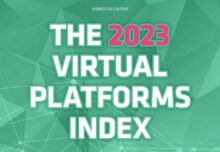More straight talk from event agency leaders on Gen Z, AI, ROI and more as they prep for the year ahead
In this second installment of our new-year discussion series, produced in collaboration with leading staffing agency Encore Nationwide (read part one here), Event Marketer sits down with another panel of veteran experiential marketing executives to hear how agencies will grow and evolve to meet the changing expectations of the market, their teams and the ups and downs of the economy. Read on for another insightful round of perspectives you can use to inform your agency businesses in this year ahead.
THE PANELISTS:
- Debbie Kaplan, Managing Director, Chief Delivery Officer, Mosaic
- Deb Lemon, CEO, On Board Experiential
- Kami Taylor, Executive Vice President, Octagon
- Jen Clines, VP of Client Strategy, Encore Nationwide
- Moderated by: Jessica Heasley, Editor & Publisher, Event Marketer
EVENT MARKETER: How are you helping your clients prove the ROI of their events? Are there new performance metrics that can, or should be deployed across events?
 DEBBIE KAPLAN, MOSAIC: ROI shows up in every RFP now but the objectives behind it may not always be clear. The RFP doesn’t always provide all of the information that an agency might be looking for to create the solution. You have to do a lot of probing and try to figure it out on your own, what they’re after. There’s a role for experiential but what is it? Is it awareness? Often brands come to us with big expectations on a limited budget wanting their activation to drive awareness through conversion. And we have to be honest and let them know, ‘Your budget will not support all of that, but let’s talk about the results you can get’ and that can help agencies and brands get to the ROI they are looking for to achieve their goals together. We’ve learned to get to what the real objective is and what else is going on in their ecosystem around it so that when we go to measure, we’re linking up to the bigger objective.
DEBBIE KAPLAN, MOSAIC: ROI shows up in every RFP now but the objectives behind it may not always be clear. The RFP doesn’t always provide all of the information that an agency might be looking for to create the solution. You have to do a lot of probing and try to figure it out on your own, what they’re after. There’s a role for experiential but what is it? Is it awareness? Often brands come to us with big expectations on a limited budget wanting their activation to drive awareness through conversion. And we have to be honest and let them know, ‘Your budget will not support all of that, but let’s talk about the results you can get’ and that can help agencies and brands get to the ROI they are looking for to achieve their goals together. We’ve learned to get to what the real objective is and what else is going on in their ecosystem around it so that when we go to measure, we’re linking up to the bigger objective.
DEB LEMON, ON BOARD EXPERIENTIAL: I think they start with what they think they want and then by the time you get through it, you have evolved your ROI to be what it should be based on the budget. It can be hard to get to the person who’s actually making the decisions. A lot of our work upfront work is trying to get to the decision maker. Some of the procurement requirements now for some of our clients includes having to have a certain level of person approving things. Because there are some clients out there who have a lot of different people doing events and then there are some that have a very narrow scope of who can do events. And we’ve got everything in between with all of our clients. But, but being able to navigate the system and understand how they value events [is critical]. Do they evaluate it as a money-making venture? Do they evaluate it as marketing spend? Customer acquisition? There are a lot of different things that you can do for it. But what is the real goal, versus what they put on paper to try to send out in an RFP. And so that comes through by getting to know them and understanding their corporate culture—how they act as a corporation.
KAMI TAYLOR, OCTAGON: And I think it’s going beyond the normal ROO and ROI. They’re asking for so much more customization around it. They’re looking to customize their return rates. Investment objectives. Brand perception. Sales cycles are taking longer. There are more touchpoints. They are also asking us for data. It’s all about data. The data informed decision. They need data analytics to understand the results.
DEBBIE KAPLAN: And the rules around how you get to that are constraining.
KAMI TAYLOR, OCTAGON: Yes. And valuations, in-depth understanding of their marketing assets. Because you get a lot of people who might not be purchasing assets if they have any idea what they’re doing with KPIs and ‘results estimates.’ They want a whole-model understanding of what the possible results could be before they even make the investment. They want to understand what they are going to get out of it.
 DEBBIE KAPLAN: Building a ‘predictive model’ is a good directional indicator of results an activation may achieve. But that’s when you need a client to be a good data partner. We have a few that will share sales data and their own product margin which can help us provide metrics that will be most meaningful to the brand and agency to ensure goals are met or where adjustments need to be made.
DEBBIE KAPLAN: Building a ‘predictive model’ is a good directional indicator of results an activation may achieve. But that’s when you need a client to be a good data partner. We have a few that will share sales data and their own product margin which can help us provide metrics that will be most meaningful to the brand and agency to ensure goals are met or where adjustments need to be made.
KAMI TAYLOR: You have to in order to create some of these proprietary, predictive dashboards that you’re trying to make for them to be able to help them understand. If they’re not a partner in giving you that info it’s almost impossible.
I thought this is interesting, too: talent best practices as an ROI. And social media influence. How do we measure that? How are we using that? And then customized ideas. Clients want something no other brand can do. That is always biggest thing for us to try to figure out from a measurement perspective.
DEB LEMON: And I think our teams like to be unique, too. Our teams don’t like the cookie cutter or to fit into a certain model. But you want to stand on the things that work or have worked in the past. So I think there’s a blend of that institutional knowledge that you have. Being able to provide the client with a better solution hopefully.
DEBBIE KAPLAN: I think to your point on perception and trying to measure that, pre and post, biometrics is going to become one of the hottest new buzzwords. It [offers] new data points and measures perception. Our ability to measure the value of someone’s emotions on top of all the other things is going to make our lives easier when someone can just check in from facial recognition. We will know their dwell time. We can track them throughout. Smiles will be an indicator of their expression and emotion, how they feel towards a brand. We’ll be able to track and measure a lot of that. They just need to opt into it.
KAMI TAYLOR: And the clients will take every bit of it because they’re not going to get approved for their dollars in the programs unless they can show [it works.]
EVENT MARKETER: How will the modern agency need to evolve to stay competitive in 2024 and beyond?
KAMI TAYLOR: I think that at our core we believe our people are our greatest asset. And we really truly believe in helping to develop and giving them the skills and the opportunities to really excel. Because it just spreads through your company and it brings the best out of everyone. And it makes your clients programs become amazing, too. So I think it’s always people that you’ve got to invest in. But technology is the other key to me. Things tied to data and analytics to help drive efficiency. Specifically first party data, where we can create our own data to bring to clients. It’s something that we’re working on.
 DEB LEMON: The people that are coming into the industry now, I have such great hope for them. I know that there’s been a lot of bashing of the younger generation, but they know what they want. They know what they like. And, I think every generation says that about the younger generations. I’m sure parents said that about us. But I think it’s learning how to harness that energy, those people’s visions. But also holding true to what our culture is at OBE. And that is creating amazing experiences for our clients and for ourselves. Because nobody wants to d, crappy work and we all want to be prideful of it. And so having fun doing that together is an extension of what we’ve been doing. Now, trying to figure out what all this other noise is around people. I think people are just making noise to create some distractions. But I think it’s finally having its seat at the table as one of the best marketing strategies that is out there. Experiential has often been the red-headed stepchild. I worked on the brand side for a while and the valuing of it as a marketing tool in the toolbox has really taken off. And I’m happy to see that happening. I would love the budgets to follow as well. And, the importance from the c-suite. But a lot of our clients, we do talk a lot to the c-suites, and they do back the events pretty heavily. I think it’s great that it’s moving in that direction. Our biggest asset is our team. We’ve had very little turnover in this last year. And I think it’s been awesome because I think we’re finding our groove.
DEB LEMON: The people that are coming into the industry now, I have such great hope for them. I know that there’s been a lot of bashing of the younger generation, but they know what they want. They know what they like. And, I think every generation says that about the younger generations. I’m sure parents said that about us. But I think it’s learning how to harness that energy, those people’s visions. But also holding true to what our culture is at OBE. And that is creating amazing experiences for our clients and for ourselves. Because nobody wants to d, crappy work and we all want to be prideful of it. And so having fun doing that together is an extension of what we’ve been doing. Now, trying to figure out what all this other noise is around people. I think people are just making noise to create some distractions. But I think it’s finally having its seat at the table as one of the best marketing strategies that is out there. Experiential has often been the red-headed stepchild. I worked on the brand side for a while and the valuing of it as a marketing tool in the toolbox has really taken off. And I’m happy to see that happening. I would love the budgets to follow as well. And, the importance from the c-suite. But a lot of our clients, we do talk a lot to the c-suites, and they do back the events pretty heavily. I think it’s great that it’s moving in that direction. Our biggest asset is our team. We’ve had very little turnover in this last year. And I think it’s been awesome because I think we’re finding our groove.
DEBBIE KAPLAN: The modern agency for us is about three things: embracing technology—I think AI is here to stay, fostering a community-first driven creative approach, and applying ethical and sustainable practices. Ethical and sustainable practices are bleeding through to everything that we’re seeing from RFPs and procurement. It’s not enough to just show the steps that we take, or, here’s how we reuse assets. That checks the box for our clients and for the marketers and for procurement. But we have to figure out a way as marketers to then make sure that the consumers are aware. It has to be things that matter to the consumer who’s actually coming to our experiences or, to our employees. People are going to come work for Mosaic because we’re living it. We’re not just talking about it.
DEB LEMON: The hard part about sustainability is that sometimes when the budget is tight, that’s the first thing that they let go. And that’s unfortunate. So that’s going to have to teach us how to be a little more creative. And I think that’s where we tap into the younger generation for their ideas on how to make it more sustainable.
EVENT MARKETER: How is your agency leveraging AI right now?
 DEBBIE KAPLAN: We are in the early stages of adoption. Our use of it internally is for creative efficiency. It helps us streamline the early stages of the creative process like creating mood boards faster. And it ties back to our client’s budgets when they only have a certain amount to work with.
DEBBIE KAPLAN: We are in the early stages of adoption. Our use of it internally is for creative efficiency. It helps us streamline the early stages of the creative process like creating mood boards faster. And it ties back to our client’s budgets when they only have a certain amount to work with.
KAMI TAYLOR: I think we’re using it more in an ad hoc way. We don’t have any particular clients that have asked for it. And I think AI is kind of like drinking the fire hose a little bit. We just have a couple departments internally, creative, strategy, using them for analytical and generative work to be more efficient, just in the day-to-day work.
EVENT MARKETER: How has face-to-face engagement changed since last year? What trends do you see driving the ways brands engage with their attendees?
JEN CLINES, ENCORE: From a tactical perspective, for the past few years we’ve been primarily supporting field marketing activations, with hyperlocal campaigns that can quickly shift gears as needed. This year, however, we have seen a strong increase in fully immersive brand experiences, including sponsorship activations at large events and tours that visit college campuses. It’s been great to get back to supporting activations with bigger footprints and higher staff counts due to the energy and excitement these experiences can create. From a staff profile and recruitment perspective, “diversity encouraged” has become the most popular request from our clients versus sharing specific demographics for staff. This is a very powerful shift as it allows us to book the best staff for each experience and brand based on personality, experience and the conversations and connections they can create with consumers versus needing to screen for a specific physical appearance.
KAMI TAYLOR: I’m seeing an incredible rise in the need for B-to-B hospitality. And not just hospitality, but what kind of interesting or different engagements you can create to capture that elusive c-suite who has a million things, is invited to everything, can buy anything that they want. What is it that we’re going to bring you to that shows value? Something they’ve never done before. It’s something where they can bring their family. Because they don’t get to spend a lot of time with their family. There are just so many different ways to do it. But I will say hospitality and hosting separate from the experiential builds and activations has grown astronomically over the past year. Almost every client’s asking about it.
EVENT MARKETER: What’s the issue creating the most friction in your ability to serve your clients right now? Budgets? Timelines? New client teams?
 KAMI TAYLOR: Being asked to do more and to be more impactful for less in shorter periods of time. There are still real capacity and supply chain issues to get things done because clients are deciding later whether they can do things. We’ve seen a lot of our clients have more layers [of approval]. So the same person that could go run with it can’t do that anymore. Now it goes to the CMO who needs to edit and there’s just so many layers. It takes so much more time to get it approved and to get it done and to get it done at the level that they require It puts a lot of strain on us and our operational partners.
KAMI TAYLOR: Being asked to do more and to be more impactful for less in shorter periods of time. There are still real capacity and supply chain issues to get things done because clients are deciding later whether they can do things. We’ve seen a lot of our clients have more layers [of approval]. So the same person that could go run with it can’t do that anymore. Now it goes to the CMO who needs to edit and there’s just so many layers. It takes so much more time to get it approved and to get it done and to get it done at the level that they require It puts a lot of strain on us and our operational partners.
DEB LEMON: There’s a lot of analysis paralysis, right? Nobody wants to make the decision. I think that you can disagree or have a debate about how things are going to happen, but at some point they’re hiring us as the expert. To say, this is the path forward that you need to go on and we need to go there so we can hit your budget and your timeline. Or the end consumer can make a decision and get there. But we need to follow that timeline. It’s not set there just because it’s arbitrary.
I also think that understanding the politics and the way the client company or the brand is run is super important. Because if you’re thinking this person’s going to give you the approval and that’s not the person, or they have 20 people they have to get to approve it, getting to that part is super fundamental to be able to, to make those decisions in a timely way.
DEBBIE KAPLAN: We’ve been doing training on this internally, and it’s pivoting away from price and having the value conversation. Not always easy to do or have depending on the level of the client, which is why we try to get to key stakeholders. It is flipping the conversation to stop talking about price and rates and budget and talk about value, which also goes back to the ROI and the data piece of it. Properly identifying and understanding the key objective what they really need to get out of the activation or the marketing campaign or program and how it delivers accordingly on their desired goals. And then having the value conversation, not the pricing conversation.
JEN CLINES: Speaking of value, ‘more for less’ from a staffing perspective is really challenging because staff pay rates have gone up so much the last three years. Some clients will say, ‘We want your best staff, but we want to pay this rate, even though it is $10 less than the current value.’ If we recruit at a lower rate, we run the risk of no one taking the job and/or having a negative perception of Encore and our client for offering such a low rate. If staff do accept the job, we run the risk of them dropping out when they receive another offer that is at market value – which causes issues if the staff have already been trained and/or if uniforms have already been order based on staff sizing. But if we’re recruiting at a competitive rate, then people feel respected, they’re excited to participate in the event, and they are more likely to show up with their A game, eager to do a great job.
KAMI TAYLOR: I think when it comes to capacity and bandwidth of your current employees to service these clients, the well can run dry. And you don’t want to over task the staff because that’s not a good employee experience. They’re not gaining the skills, they’re being spread too thin. So where does the balance come in when taking on new projects? Servicing your retainer clients, giving them the time that they need, and then maybe even using freelancers, right? Contractors to come help fill the gap. Burnout and bandwidth is an issue. I do feel like it’s worse since the pandemic.
DEBBIE KAPLAN: The pandemic facilitated the ‘always on’ culture for businesses. This is especially true for event-based companies like ours that operate seven days a week. And technology, such as Zoom, has further enabled that.
Read part one of the roundtable here.
Image credit: tommy






